Nothing is more fascinating than the architectural marvels of Hampi, Badami, Pattadakal and Aihole. An entire township filled with the glorious stone pillars, pathways, stepwells, Mahals, temples with towering gateways laden with carved intricacies in awe inspiring precision is what makes the arid towns of Hosapete and Bagalkot an enchanting experience where one gets to explore the rich heritage and lifestyles of our glorious kings. Watching the rusty radiance of these sandstone structures on a moderately sunny day is something I can do endlessly.
Our trip to Hampi a few years back was very enriching so this time, we spent time only in Badami and Aihole.
We set off driving on a lazy afternoon from Bengaluru via Tumkur on NH47 road up to Chitradurga and NH50 up to Hospet route to reach Hampi is 375kms and a 7hours long drive without taking breaks.
After a day’s halt at Hampi we resumed our journey to Badami by 5pm in the evening.
Hampi to Badami is 160kms and a drive of 2.45 hours on NH397 _ Bevoor_ Gadag road. While we were still enamored by the seamless visionaries that the Vijayanagar kings were for having chosen to establish their erstwhile capital by putting their natural surroundings to best use amidst enclaves of rocky dunes that served as a natural security barricade while the Tunga River satiated their water needs, but what stood in store on the NH397 was quite the opposite as the highway was laden with not just highway men but also women, defecating in the open! It was as if a whole town was out there congregating in a mass-relieving exercise and that too while chatting away to glory on their mobile phones with little plastic mugs of water beside them. The headlights of the zipping vehicles served as a torch perhaps.
The water scarce, arid zones of northern Karnataka are really appalling and a grim reminder of today’s callous administration!
As we zoomed past pictures of rural reality, we could only pray that our resort booking in Badami had enough waters for our basic rituals because the more we traversed the lesser were our hopes of even getting a decent accommodation, on the dusty uneven roads(ditches) of Bagalkot until we reached what looked like a tar road but with several beauty spots in the form of pot holes.
Fortunately our hotel ‘Heritage Resorts’ in Badami was a nice and clean, decent place with a vegetarian kitchen, cozy comfortable beds and we could not have asked for more.
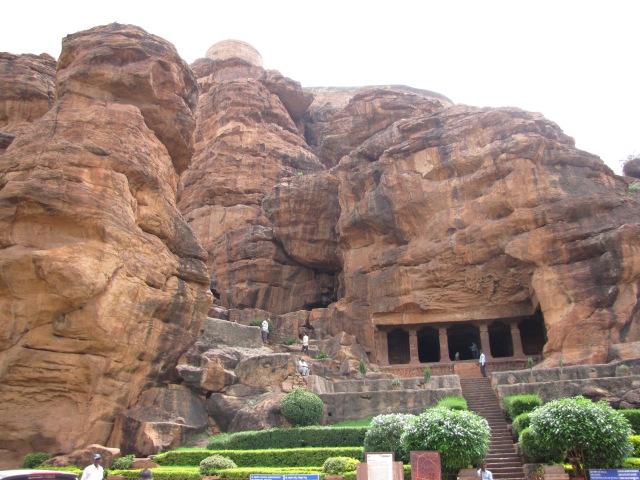
Badami in Kannada means almond, due to its almond colored sandstone architectures the city was called Badami. Badami was earlier known as Vatapi owing to the legend of demon Vatapi and sage Agasthya.
“Vatapi and Ilvaku were two demons who hounded sages with their tricks. They would lure the sages into a feasting meal, where Vatapi would take the form of food and be served by Ilvaku to the sages, once the sages had feasted then Ilvaku would call out Vatapi to return. Vatapi would emerge from the sage’s stomach thereby killing them. But when Agasthya rishi was served this tricky lunch, he immediately said “Vatapi Jeerno Bhava” meaning let Vatapi be digested, that was the end of the demons.
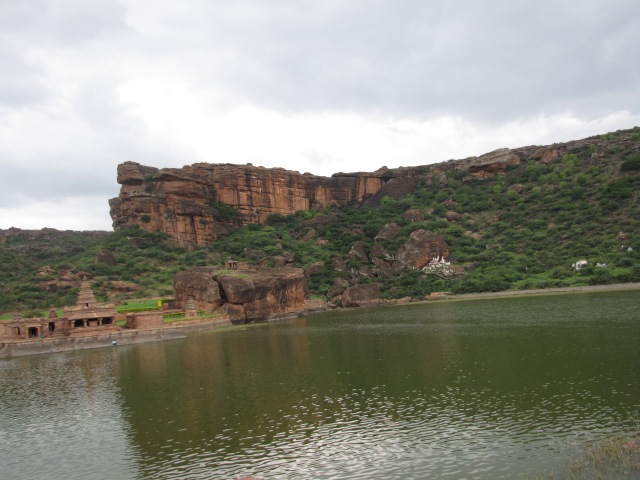
Badami, was the capital of the Chalukya kings who ruled from the 450AD to 757AD, Jayasimha was the founder of the Chalukya dynasty. These rock cut caves were undertaken during King Pulakeshi’s time and completed by King Mangalesha. After the Chalukyas, Badami was ruled by Pallavas, Rastrakutas, Hoysalas followed by the Vijayanagara kings, Adil Shahis, Marathas, Odeyars, Hyder Ali and British. The Pallavas who invaded Chalukyas, took away a statue of Lord Ganapathi (flat stomached idol, the only idol of Ganapathi in his flat tummy) as booty and placed it in Thiruvarur. The 17th century poet Muthusamy Dikshitaar praises this idol in his song ‘Vatapi Ganapathim Baje’ as the idol was from Vatapi(Badami).
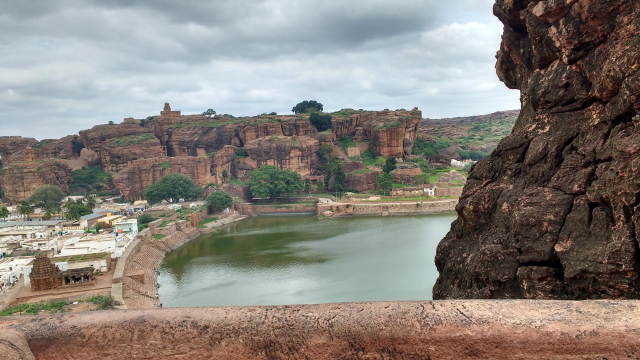 The Cave temples located beside the Agastya Theertha is the main attraction, the sandstone structure with 2000 steps is a steep summit of gigantic rocks that houses four caves(a fifth one is discovered recently).
The Cave temples located beside the Agastya Theertha is the main attraction, the sandstone structure with 2000 steps is a steep summit of gigantic rocks that houses four caves(a fifth one is discovered recently).
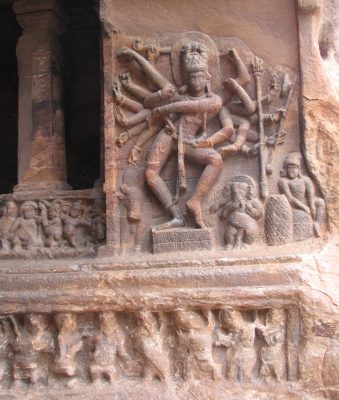 The 1st cave depicts Shaivism with Shiva as Nataraja in his dancing form with 18 hands.
The 1st cave depicts Shaivism with Shiva as Nataraja in his dancing form with 18 hands.

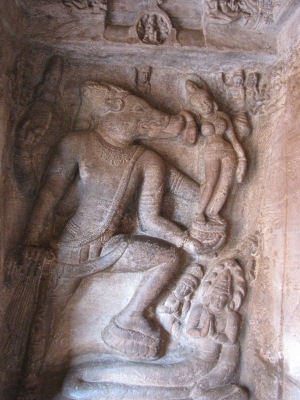
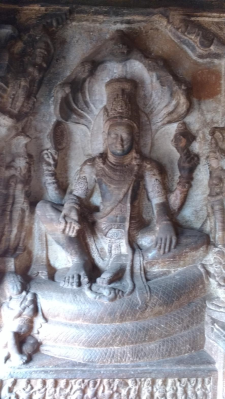 The second cave is dedicated to Lord Vishnu with panels of Vamana-Trivikrama and Bhoovaraha. The ceilings have Swastika symbols carved and MatsyaChakra(fish wheel), Puranic episodes of SamudraManthana and Krishna’s tales can be seen.
The second cave is dedicated to Lord Vishnu with panels of Vamana-Trivikrama and Bhoovaraha. The ceilings have Swastika symbols carved and MatsyaChakra(fish wheel), Puranic episodes of SamudraManthana and Krishna’s tales can be seen.
Cave 3 is again dedicated to MahaVishnu, it is the largest and most ornate caves of all, it was completed by King Mangalesha.
Cave 4 is a Jaina cave temple, the smallest of all, you can get an excellent view of the Agastya Theertha in the backdrop of Bhootnath temples and the scenic range of sandstone rocks.
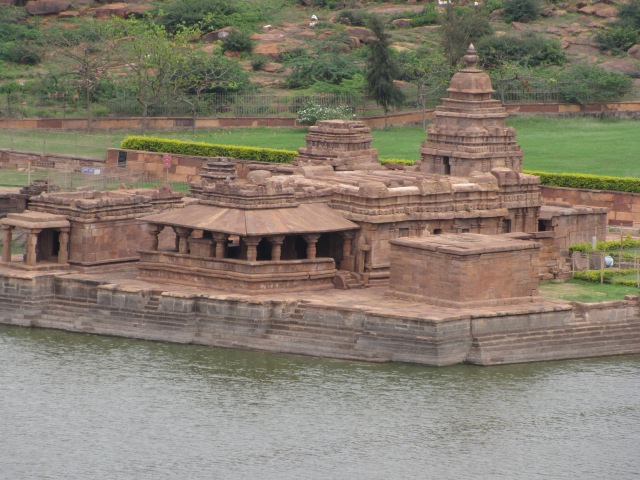
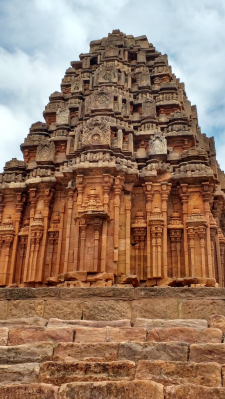
 After descending from the caves we headed to the Badami Museum which is just some 200meters away. A narrow and dirty path ridden with pigs, open gutters and small dingy houses in all its filth surrounds this UNESCO World Heritage Site in the immediate vicinity. A mosque is also built in the same sandstone material right next to the caves, like in most of all our heritage sites/temples. This one was perhaps from the Adil Shahi’s times. But the overall filth surrounding the monumental wonder is acrimonious apathy of successive governments. However the locals told me that the Modi government has already undertaken to make things better.
After descending from the caves we headed to the Badami Museum which is just some 200meters away. A narrow and dirty path ridden with pigs, open gutters and small dingy houses in all its filth surrounds this UNESCO World Heritage Site in the immediate vicinity. A mosque is also built in the same sandstone material right next to the caves, like in most of all our heritage sites/temples. This one was perhaps from the Adil Shahi’s times. But the overall filth surrounding the monumental wonder is acrimonious apathy of successive governments. However the locals told me that the Modi government has already undertaken to make things better.
 As of now whether it is in Hampi, Badami or AIhole there are no strict safety or security measures for the upkeep. If you go to the Taj Mahal or the Red Fort or Humayun Tomb in the north one can see the kind of elaborate security measures, CCTV screening and numerous guards at every point but the Hampi, Badami, Aihole are sites where the whole town is a monumental wonder with numerous breath taking structures, all of them without much security deployed and with unapologetic tourists with no regard for the grandeur of the heritage site as they call it ruins.
As of now whether it is in Hampi, Badami or AIhole there are no strict safety or security measures for the upkeep. If you go to the Taj Mahal or the Red Fort or Humayun Tomb in the north one can see the kind of elaborate security measures, CCTV screening and numerous guards at every point but the Hampi, Badami, Aihole are sites where the whole town is a monumental wonder with numerous breath taking structures, all of them without much security deployed and with unapologetic tourists with no regard for the grandeur of the heritage site as they call it ruins.
If this kind of extravaganza were to be in any other Western country it would perhaps arrange guided digital tours with Walkie talkies aiding tourist to re-live this ancient history. If it is maintained and propagated even today its rich heritage can make Karnataka synonymous with Hampi. But today most North Indians are not even aware of this glorious place called Hampi, Badami and Aihole as it is not given the importance like other Mughal monuments.
Most sites are at the mercy of the tourist guides who demand 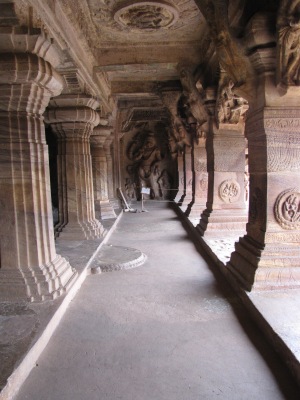 anything like Rs.500 for two hours when you need a whole day to cover just 8-10 places. Hampi has some 550 places where some 54 are UNESCO recognized heritage sites and Badami takes 2full days.
anything like Rs.500 for two hours when you need a whole day to cover just 8-10 places. Hampi has some 550 places where some 54 are UNESCO recognized heritage sites and Badami takes 2full days.
We spent some 30-40minutes at the museum and then took a stroll along the Agastya Theertha. Walking beside the serene holy waters enclaved by gigantic sandstone rocks amidst green patches feels blissful.
This route leads to the Bhootnath temples, a place that was once filled with scents of flowers, bells clanging and Vedic Mantras, the Kalyani where holy baths were taken is today devoid of the main idol itself, as we neared the Bhootnath temples, we could see groups of ladies washing utensils and clothes in the Agastya Theertha polluting it with detergents and soaps.
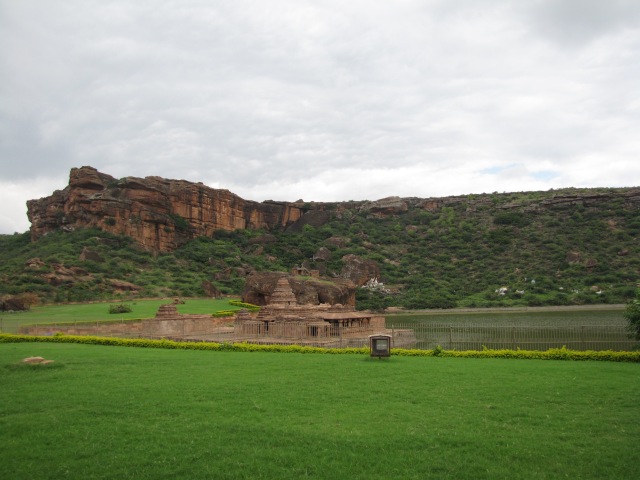 The Bhootnath temples are a group of Shiva temples located on the far end of the Agastya lake, with both Nagara style and Dravidian style architecture. One can sit here in eternal solace watching those majestic almond reflections in the gleaming waters calmly.
The Bhootnath temples are a group of Shiva temples located on the far end of the Agastya lake, with both Nagara style and Dravidian style architecture. One can sit here in eternal solace watching those majestic almond reflections in the gleaming waters calmly.
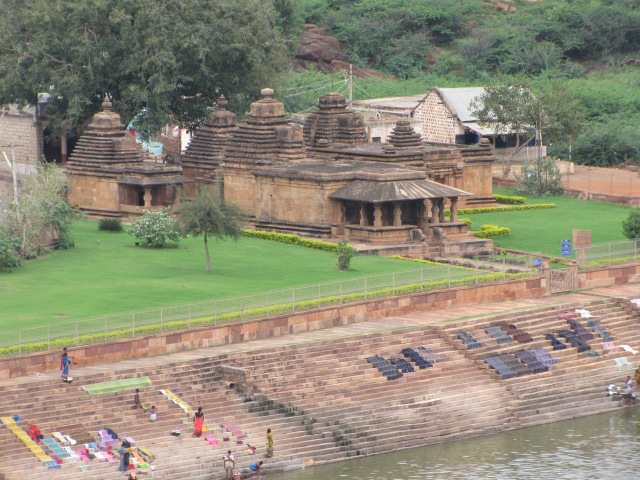
A little away from the Bhoothnath temples on the left side is the Mallikarjuna temples, a plainer version of Shiva temples of Kadamba times.
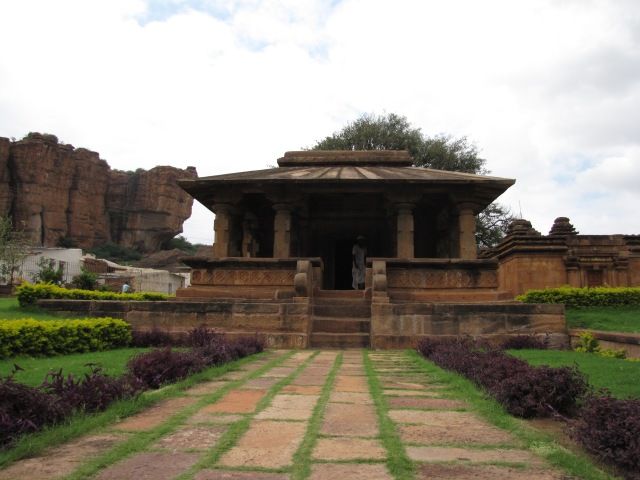
A whole lot of temples but no prayers offered anywhere here as it is customary in Hindu temples that once a Vigraha or idol is broken even if partly then no Pooja is offered. Today it is a much sought after place for cinema shootings and adventure enthusiasts for rock climbing as Badami has its own rock climbing camps.
We completely missed out the Shivalay temples, the fort and the Vatapi temple where once the unique idol of Lord Ganesha with a flat tummy was worshipped here before being taken away as booty by the Pallava kings.
Badami has mostly budget hotels and very few luxury hotels, it is well connected by rail, bus and ideal to visit from October to January.
And as we are celebrating the Hampi festival now, let us hope and pray that the apathy and callousness of the Government takes a turn for the better. It is indeed sad that such architectural marvels stand amidst total break down of infrastructure and basic amenities. It is ironical that these temples have stood the test of time and the city and towns and villages of more recent times are in shambles and ruins. Very pathetic, and Mayura, I find this trend everywhere in Karnataka, most of the tourist rich places do not have roads and not even sign boards. A country seeped in such culture and heritage is really going to the dogs owing to the poor Governance. Well, even in places such as Tanjavur in TN, this is the same story, beautiful marvels surrounded by filth.
LikeLike
Lack of respect for our rich cultural heritage is the reason for the apathy, and yes these beautiful places are surrounded by such filth that it is shocking that the locals don’t even realize it or care about it. Very sad indeed!
LikeLiked by 1 person
Very well written post.. When we visited, we also experienced the same feelings which you did.. Such an amazing place not being given the appropriate attention is truly a very sad thing.
LikeLike
Thanks for stopping by, yes it is an amazing place, I heard that the central govt is taking keen interest in developing the area, hopefully it is addressed.
LikeLiked by 1 person
That’s a great news. Hopefully the problems are somehow taken care of.
LikeLike
Well written and nice photographs.
LikeLiked by 1 person
Thank you Sapna!
LikeLike